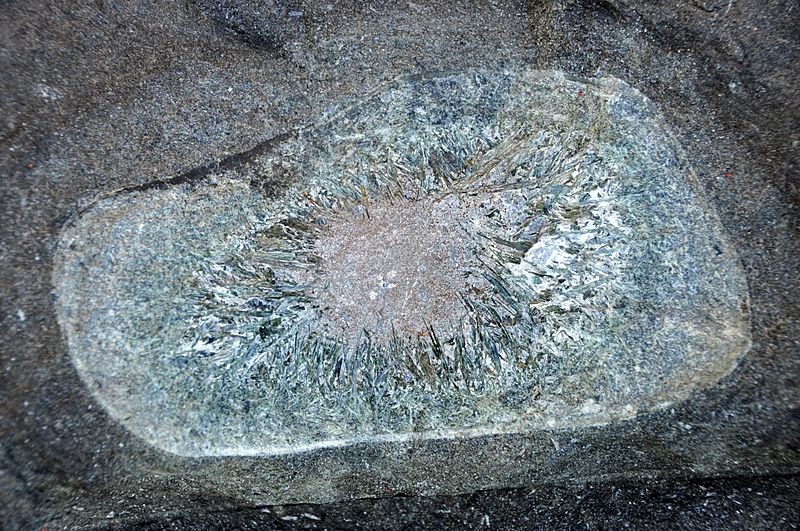Image: Lamprophyre with xenolith (Dubreuilville Dike, Archean; Route 17 roadcut southeast of Princess Lake & north of Wawa, Ontario, Canada) 26

Description: Lamprophyre in the Precambrian of Ontario, Canada. The is part of an igneous dike composed of a rare igneous rock called lamprophyre. Such rocks are ultrapotassic, mafic to ultramafic, intrusive igneous rocks. This one is a gray hornblende lamprophyre with altered mantle xenoliths (= object at center; "xeno" = foreign; "lith" = rock). Xenoliths are pieces of rock that have fallen from the walls or roof of a cooling magma chamber. The examples at this locality are composed of talc and acicular/bladed actinolite. Description from Wilson (2006): These rocks are characterized by prominent round, to elliptical inclusions of actinolite or actinolite plus talc. Xenoliths are altered to fine-grained actinolite with or without talc, and some display zoning from talc core to an actinolite rim. The actinolite inclusions may consist of prismatic green crystals as large as 8 centimeters in length, which may be randomly oriented or radiating inward towards the core. The inclusions containing talc consist of a talc core with the prismatic to acicular actinolite projecting radially inward towards the core. The xenoliths are believed to represent at least two original mafic compositions which are likely to be originally of lower crust origin or deeper. This dike may be the one described by Higgins (1986). He reported that the dike consists of 60% euhedral amphibole, 20% biotite replacing amphibole and 15% plagioclase. Minor sphene and opaque minerals are present and chromite is reported from the core of the talc-bearing clasts. The bulk composition of the nodules is reportedly pyroxenite, but Higgins did not indicate whether their source was mantle or crust. The rounded outline of the clasts may reflect magmatic erosion during transport and the present mineralogy is the product of regional metamorphism (Higgins 1986). Geologic unit and age: Dubreuilville Dike, Archean Locality: Route 17 roadcut, south of the Route 519-Route 17 intersection, southeast of Princess Lake & north of the town of Wawa, Ontario, southeastern Canada (48° 15' 12.05" North latitude, 84° 52' 59.72" West longitude) See info. at: en.wikipedia.org/wiki/Lamprophyre and en.wikipedia.org/wiki/Xenolith References cited: Higgins (1986) - Nodule-bearing spessartite (lamprophyre) dike near Wawa, northern Ontario. GAC-MAC-GCU-AGC-AMC-UCG Program with Abstracts 11: 81. Wilson (2006) - Unusual diamond-bearing rocks of the Wawa area. Institute on Lake Superior Geology, 52nd Annual Meeting, Sault Ste. Marie, Ontario 52(3).
Title: Lamprophyre with xenolith (Dubreuilville Dike, Archean; Route 17 roadcut southeast of Princess Lake & north of Wawa, Ontario, Canada) 26
Credit: https://www.flickr.com/photos/jsjgeology/48296814297/
Author: James St. John
Usage Terms: Creative Commons Attribution 2.0
License: CC BY 2.0
License Link: https://creativecommons.org/licenses/by/2.0
Attribution Required?: Yes
Image usage
The following page links to this image:

